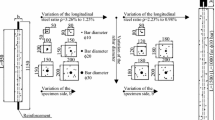Abstract
This study proposes a model for calculating the average width of cracks in reinforced concrete (RC) elements using non metallic reinforcement bars (FRP). This model has already been applied to the case of steel reinforcing bars successfully. It considers the influence of the percentage of reinforcement and the concrete strength. It emphasizes how the mechanical features of FRP (fiber reinforced polymer) bars, and particularly their modulus of elasticity, can affect the crack width. The model is validated with experimental results available in the literature. An example of its application for the calculation of the crack width is shown.
Résumé
Cet article présente l'application d'un modèle de prévision de l'amplitude des fissures en présence d'armatures non métalliques et de classes de résistance du béton allant de 30 à 80 MPa. L'analyse théorique est utilisée pour interpréter les résultats d'essais expérimentaux sur des traverses en béton armé contenant des polymères renforcés de fibres (FRP) soumises à des forces de traction.
Le but de cette recherche était d'étudier et de prévoir la largeur des fissures, en utilisant comme paramètres de base la contrainte dans l'acier et la distance moyenne entre les fissures. La recherche décrit aussi l'amplitude des fissures, pour la même traverse, en présence d'armatures en acier et en polymères renforcés de fibres (FRP).
Similar content being viewed by others
References
ACI, Building Code requirements for structural concrete, (ACI 318-95) and Commentary (ACI 318R-95).
AIJ, Recommendations for Design and construction of partially prestressed concrete, 60–62, 1986.
BS Institute, ‘Code of practice for design and construction’, BS8110 Part 2, London 1985.
Model Code '90, Bulletin d'Information no 213/214, Thomas Telford Editor, May 1993.
Faza, S. S. and GangaRao, H. V. S., ‘Glass FRP reinforced bars for concrete’ Fiber Reinforced plastic (FRP) Reinforcement for Concrete Structures: Properties and applications, A. Nanni Editor, Elsevier, Amsterdam, 1993, 167–189.
Recommendations for Design and construction of concrete structures using continuous fiber reinforcing materials, Concrete Eng. Series, No. 23, Edited by A. Machida, Tokyo, Japan, September 1997, 27–31.
Mogahadam, M. and Sentler, L., ‘GFRP as crack control reinforcement’, Non-metallic (FRP) reinforcement for concrete structures-Proc. of The Sec. Int. Rilem Symp. (FRPRCS-2), Edited by L. Taerwe, August 1995, Ghent, 243–250.
Watstein, D. and Bresler, B., ‘Reinforced Concrete Engineering’, Vol. 1 John Wiley and Sons, 1972.
Gergely, P. and Lutz, L. A., ‘Maximum crack width in reinforced concrete flexural members: Causes, mechanisms, and control of cracking in concrete’, SP-20, American Concrete Institute. Detroit, 1960, 87–117.
Lutz, L. A., ‘Crack control factor for bundled bars and for bars of different sizes’,ACI Journal Proc. 71 (1) January (1974) 9–10.
Taerwe, L. and Pallemans, I., ‘Force transfers of AFRP bars in concrete prisms’, Non-Metallic (FRP) reinforcement for Concrete structures-Proc. of The Sec. Int. Rilem Symp. (FRPRCS-2), Edited by L. Taerwe, August 195, Ghent., 154–163.
Joh, O., Wang, Z. and Goto, Y., ‘Experimental study on bond cracking performance of FRP reinforcement concrete’, Proc. of the Third Int. Symp. (FRPRCS-3), Vol. 2, Sapporo, Japan Concrete Institute, October 1997, 431–446.
Zhao, W., Pilakoutas, K. and Waldron, P., ‘FRP reinforced concrete: Cracking behavior and determination’, Proc. of the Third Int. Symp (FRPRCS-3), Vol. 2, Sapporo, Edited by Japan Concrete Institute, October 1997, 439–446.
Kobayashi, K., Rahman, H. and Fujisaki, T., ‘Crack width prediction for NEFMAC-Reinforced flexural members, Proc. of the Third Int. Symp. (FRPRCS-3), Vol. 2, Sapporo, Edited by Japan Concrete Institute, October 1997, 447–454.
Achillides, Z., Pilakoutas, K. and Waldron, P., ‘Bond of FRP anchorages and splices in concrete beams’, ECCM-8 Naples, Vol. 2, Editor I. Crivelli Visconti, June 1998, Naples, 277–284.
Greco, C., Manfredi, G., Pecce, M. and Realfonzo, R., ‘Experimental analysis of bond between GFRP deformed rebars and concrete’, ECCM-8, Vol. 2, Editor I. Crivelli Visconti, June 1998, Naples, 301–308.
Blaschke, M., Niedermeier, R. and Zilch, K., ‘Bond failure modes of flexural members strengthened with FRP’, Proc. of Sec. Int. Conf. on Comp. in Infrastructure, Tucson, Arizona, Vol. 1, Edited by H. Saadatmanesh, M.R. Ehsani, January 1998, 315–327.
Nolan, G., Zaki, D., Mahmoud, I. and Sami H. Rizkalla, ‘Bond properties of carbon fiber composite prestressing strands’ACI Structural Journal 95 (3) (May–June 1998) 281–290.
Nanni, A., Al-Zahrani, M., Al-Dulaijan, S. U., Bakis, C. E. and Boothby, T. E., ▪Bond of FRP reinforcement to concrete experimental results’, Proceedings, FRPRCS-2, University of Ghent, Belgium, Aug. 23–25, 1995, 135–145. (Principal Author)
Lee, Y. J., Tripi, M., Boothby, T. E., Bakis, C. E. and Nanni, A., ‘Tension stiffening model for FRP sheets bonded to concrete’, Proceedings of Sec. Int. Conf. on Comp. in Infrastructure, Tucson, Arizona, Vol. 1, Edited by H. Saadatmanesh, M. R. Ehsani, January 1998, 175–186.
Gupta, A. K. and Maestrini, R., ‘Tension stiffening model for reinforced concrete bars’,ASCE Journal 117 (3) (March, 1989).
Creazza, G., Di Marco, R., Russo, S. and Siviero E., ‘Tension stiffening in high strength concrete’, Fourth Int. Sym. on the ‘Utilization of high strength/high performance concrete’, 29–31 May, Paris 1996, 1135–1143.
Creazza, G. and Russo, S., ‘A new model for predicting crack width with different percentages of reinforcement and concrete strength classes’,Mater. Struct. 32 (221) (Aug.–Sept. 1999).
Creazza, G., Di Marco, R., Russo, S. and Siviero, E., ‘Tension stiffening and cracking behavior in High Strength Concrete’, 105–124, ACI Special publication SP 180, Editor Roberto Leon 1998.
Author information
Authors and Affiliations
Rights and permissions
About this article
Cite this article
Creazza, G., Russo, S. Crack width evaluation in FRP reinforced concrete members. Mat. Struct. 34, 119–125 (2001). https://doi.org/10.1007/BF02481561
Received:
Accepted:
Issue Date:
DOI: https://doi.org/10.1007/BF02481561




